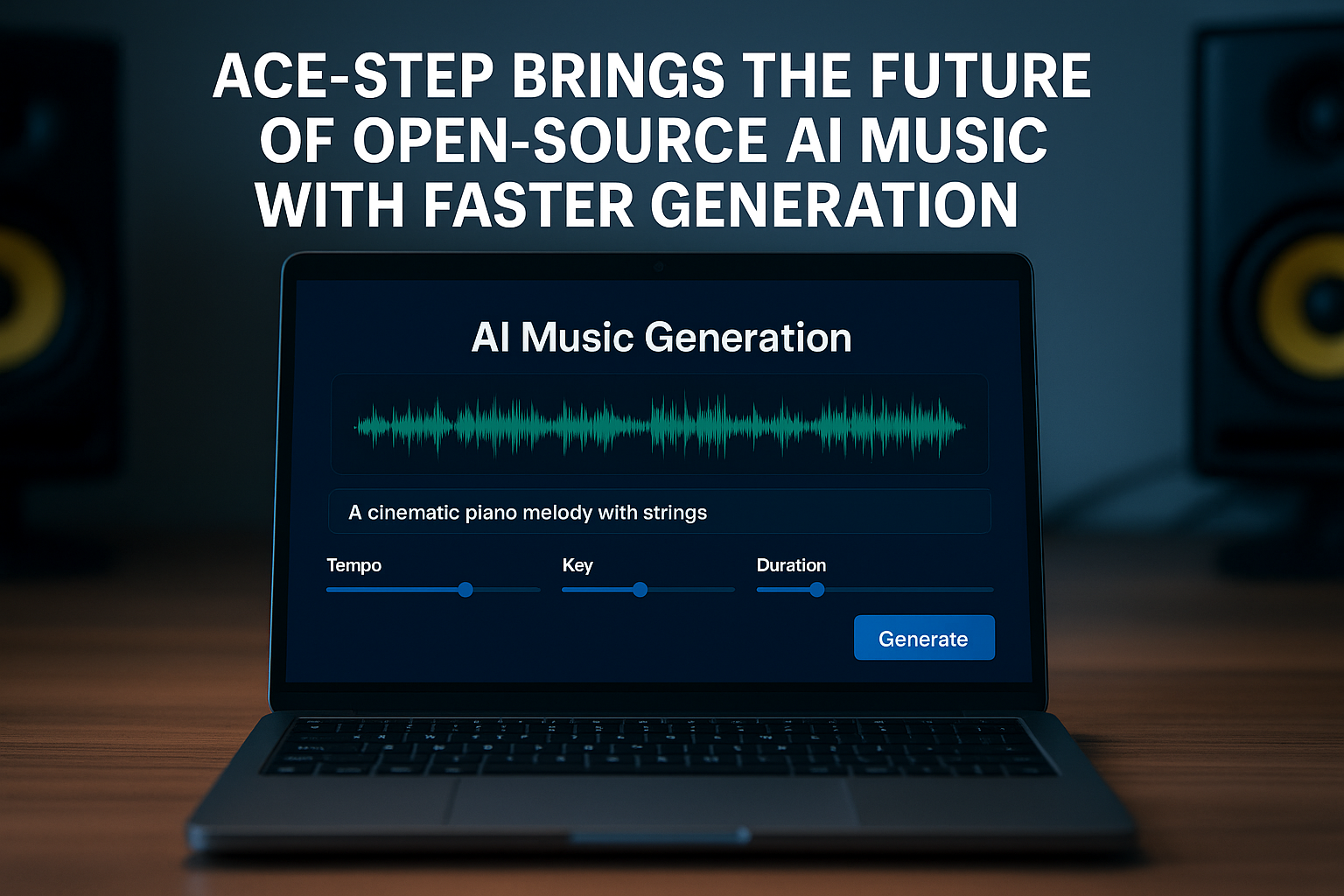The world of AI-generated music is entering a new era with the launch of Ace-Step—a powerful open-source foundation model co-developed by ACE Studio and StepFun. Licensed under Apache 2.0, Ace-Step is designed to overcome the limitations of existing models through a holistic architecture that combines diffusion-based generation, Sana’s Deep Compression AutoEncoder (DCAE), and a lightweight linear transformer.
This trifecta enables state-of-the-art speed, coherence, and control, positioning Ace-Step as a serious contender to commercial tools like Udio and Suno AI—while remaining fully open for the community to experiment with, customize, and extend.
What Makes Ace-Step Unique?
High-Speed Generation
Ace-Step is 15× faster than traditional LLM-based music models, capable of producing a 4-minute track in just 20 seconds on an NVIDIA A100. This is made possible by its efficient diffusion-based approach combined with a compressed representation via DCAE.
Superior Musical Coherence
The model delivers tight integration between melody, harmony, and rhythm, avoiding the disjointed or repetitive patterns seen in many other generative tools.
Full-Track, Text-to-Music Generation
Ace-Step supports natural language prompts, duration control, and full-song generation—not just loops or short clips. This makes it ideal for end-to-end music creation from scratch.
Use Cases
Direct Applications
- Text-to-music generation (e.g., “a lo-fi hip-hop beat with ambient rain sounds”)
- Music remixing and style transfer
- Lyric editing with vocal consistency
- Audio inpainting to regenerate missing or edited sections
Downstream Integrations
- Voice cloning and synthesis pipelines
- Genre-specific tools (e.g., rap, jazz, orchestral music)
- Creative assistants for songwriters and producers
- AI-powered DAW plug-ins and music apps
Hardware & Performance
Ace-Step is powerful, but it comes with demanding requirements for optimal performance.
| Device | 27 Steps RTF | 60 Steps RTF |
|---|---|---|
| NVIDIA A100 | 27.27× | 12.27× |
| RTX 4090 | 34.48× | 15.63× |
| RTX 3090 | 12.76× | 6.48× |
| Apple M2 Max | 2.27× | 1.03× |
RTF (Real-Time Factor): Higher values mean faster generation relative to real-time audio length.
Local deployment is possible on consumer hardware, though it is slower. A Hugging Face demo is available for instant access, though often backlogged due to demand.
Known Limitations
While groundbreaking, Ace-Step is not without issues:
- Language variation: Best results in top 10 languages (e.g., English, Chinese, Japanese); others may perform inconsistently.
- Structural drift: Longer tracks (>5 min) may lose musical cohesion.
- Instrument diversity: Rare or niche instruments may not render realistically.
- Output inconsistency: Random seeds significantly affect results (“gacha-style” variability).
- Genre weaknesses: Underperforms on styles like Chinese rap (
zh_rap) and may lack genre-specific flair. - Repainting flaws: Unnatural transitions when extending or overwriting sections.
- Vocal roughness: Coarse synthesis quality; lacks emotive nuance and articulation.
- Control limitations: Needs finer-grained parameters for tempo, dynamics, and harmony.
Model Architecture Highlights
Ace-Step’s performance stems from:
- DCAE: Compresses audio to a latent space, reducing computational load while preserving quality.
- Diffusion model: Enables flexible and high-fidelity generation.
- Linear Transformer: Lightweight yet effective for temporal modeling and long-range coherence.
Together, these components allow Ace-Step to generate realistic, full-length music tracks far more efficiently than transformer-heavy LLM music systems.
Coming Soon: Advanced Add-ons
Ace Studio has teased several upcoming LoRA (Low-Rank Adaptation) modules, including:
- Rap Machine: Fine-tuned on rap data for specialized hip-hop generation.
- StemGem: Generates individual instrument stems for post-processing flexibility.
- Singing-to-Accompaniment: Reverse process that creates full backing tracks from raw vocal recordings.
These additions will further expand Ace-Step’s versatility for both amateur and professional musicians.
How to Get Started
Final Thoughts
Ace-Step is more than just a generative model—it’s a platform for open creativity in music. It balances speed, flexibility, and openness in a way no other open-source music model has yet achieved.
Whether you’re remixing a lo-fi beat, building a vocal assistant, or developing a new kind of DAW, Ace-Step is the model to watch in 2025.
